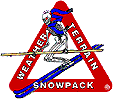Online Level 1 Avalanche Course
Module 4 Description - Avalanche Weather 1
Select Feedback
- The average student rating for this module, out of 10, is: 9
- The average student rating for this module in relation to others, out of 10, is: 9
- The percentage of students who felt all objectives were met is: 100%
- Select Student Comments:
- The incident case study of Mt. Hood was a good way of explaining energy balance.
- Overall I think I got the material, and a lot of it was very good.
- The graphics we very helpful.
- The Mt Hood incident was interesting since it is in my backyard.
- The time required was reasonable
- I felt prepared for all assessments
Overview
This is Module 4 of the Level 1 Avalanche Class developed and supported by AlpenPro and offered here in the Avalanche Institute. It covers all of the weather material for the Level 1 course.
The only co-requisite for this module is Module 1 - Preliminary (or Background) Material. This module is a prerequisite for several others and is required for Field Day #1 of the Level 1 course or the shorter Awareness version.
The module covers key observables, climates, local and topographic weather effects, and locating and interpreting suitable forecast products. The emphasis is on applied topics with a little background theory to provide insight and understanding and to build a basis for further studies.
Objectives
- Explain why winds in the atmosphere differ from winds at the surface
- List key observables and explain how they can contribute to snowpack instability
- Describe the differences in typical winter weather between different climate zones
- Identify and describe several local and/or topographic weather effects
- Locate and interpret general (non-specialized) weather forecast products
- Interpret the contents of a mountain weather forecast
Topics
This module covers four general topics:
- Key Observables
- Climates
- Local / Topographic Effects
- Forecast Products and Interpretation
Each of these is broken down further into sub-topics within the course, the Outline on this page shows more detail.
Outline
Welcome, Instructions
Introduction
Wind, Energy, Precipitation
Key Observables - Wind
- Origins of Wind
- Wind Transport of Snow
- Distribution of Windblown Snow
Key Observables - Energy Balance
- Mechanisms of Heat Transfer
- Radiation Experiments
- Energy Balance at the Snow Surface
Key Observables - Precipitation
- Types of Precipitation
- Ice Crystals
- Optional Exercise
- New Snowfall
Snow Climates
- Climate
- Climate Comparison
Local Weather Effects
- Orographics
- Inversions
- Convergence Zones
- Other Localized Weather
Forecast Products and Interpretation
- Weather Forecasts
- NWS Forecasts (US)
- Wx Planning Sheet
Wrap-Up
- Final Case Study
- Conclusion
- Review
Human and technical Resources
This is probably the most interactive module in the Level 1 course in terms of feedback from instructors. Several assessments in this section are submitted using the drop box for review by an instructor, who will provide feedback via the drop box comment feature. A module forum is available to post any questions or comments.
Assessment
There are quizzes incorporated into this course which allow students to check their understanding of the material. Quizzes may be taken as many times as desired, either to obtain a passing score or just to attempt to ultimately get a perfect score.
Several assessments in this section require the student to submit something using the drop box. These are reviewed by an instructor and feedback is provided via the comment feature of the drop box. Other quizzes are taken and scored online.
Successful completion of this module requires passing all assessments.
Course material
Most of the materials included in this module are from a workbook developed and used by AlpenPro. A few items are from the Avalanche Center website. Links are provided to external resources where appropriate.

 Avalanche Institute Home
Avalanche Institute Home